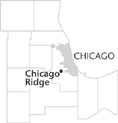| Entries |
| C |
|
Chicago Ridge, IL
|
 Cook County, 15 miles SW of the Loop. Chicago Ridge's irregular shape is bounded by
Oak Lawn
on the north and east,
Bridgeview
on the west, and
Worth
on the south. Its early geographic and historical context parallels that of Worth.
Cook County, 15 miles SW of the Loop. Chicago Ridge's irregular shape is bounded by
Oak Lawn
on the north and east,
Bridgeview
on the west, and
Worth
on the south. Its early geographic and historical context parallels that of Worth.
The path of Stony Creek arcs through the village. It is not only an old creek but also the remnants of a feeder canal for the Illinois & Michigan Canal that reached from the Little Calumet River westward through the Saganash-kee Slough. Although the work on the feeder canal brought some settlers in the 1840s, German and Dutch farmers arrived after the 1850s.
Settlement increased with the coming of the Wabash, St. Louis & Pacific Railroad in 1882. Later, the Wabash would be crossed in the middle of Chicago Ridge by the Chicago & Calumet Terminal Railway, which also established rail yards in the village.
In 1898, the Paul E. Berger Company, manufacturers of cash registers and slot machines, located adjacent to the railroad. The Berger Company built housing for its employees, and a settlement emerged around the factory, with a tavern, rooming house, and grocery store. The first post office opened in 1900 in the Berger factory, and in 1902 the Wabash Railroad established a train station.
Both Chicago Ridge and Worth benefited from the activity and economic influences of a racetrack operating on 111th Street. Local residents proudly recall that a member of one of the founding families of the Chicago Ridge area, Fred Herbert, won the Kentucky Derby in 1910. The racetrack was torn down in 1911 and is now the site of Holy Sepulchre Cemetery.
After Oak Lawn incorporated in 1909, Chicago Ridge and Worth both considered the move. An incorporated government could replace wooden sidewalks, deal with the stagnant waters in the swampy areas, initiate local municipal services and provide locally elected and accountable officials. Both Chicago Ridge and Worth incorporated in 1914. Chicago Ridge grew from 176 in 1920 to 888 in 1950. With the great demand for housing and the expansion of road networks to include expressways, Chicago Ridge was poised for growth. Along with a strong new industrial and commercial base, the population increased dramatically, to 5,748 in 1960 and 14,127 in 2000.
| Chicago Ridge, IL (inc. 1914) | |||||
| Year |
Total
(and by category) |
Foreign Born | Native with foreign parentage | Males per 100 females | |
| 1930 | 269 | — | — | — | |
| 1960 | 5,748 | 2.9% | 16.1% | 105 | |
| 5,729 | White (99.7%) | ||||
| 19 | Other races (0.3%) | ||||
| 1990 | 13,643 | 7.9% | — | 94 | |
| 13,400 | White (98.2%) | ||||
| 40 | Black (0.3%) | ||||
| 24 | American Indian (0.2%) | ||||
| 96 | Asian/Pacific Islander (0.7%) | ||||
| 83 | Other race (0.6%) | ||||
| 519 | Hispanic Origin* (3.8%) | ||||
| 2000 | 14,127 | 13.5% | — | 94 | |
| 12,592 | White alone (89.1%) | ||||
| 345 | Black or African American alone (2.4%) | ||||
| 32 | American Indian and Alaska Native alone (0.2%) | ||||
| 207 | Asian alone (1.5%) | ||||
| 277 | Some other race alone (2.0%) | ||||
| 674 | Two or more races (4.8%) | ||||
| 883 | Hispanic or Latino* (6.3%) | ||||
The Encyclopedia of Chicago © 2004 The Newberry Library. All Rights Reserved. Portions are copyrighted by other institutions and individuals. Additional information on copyright and permissions.